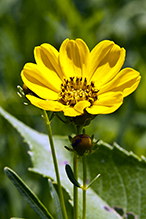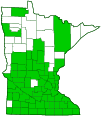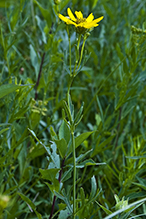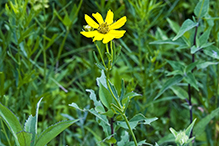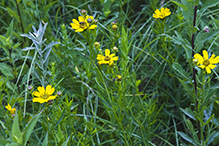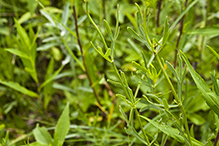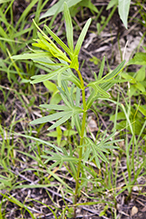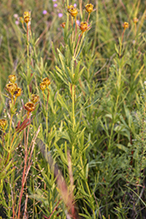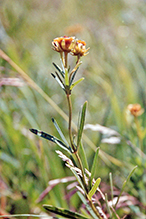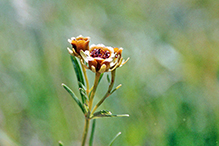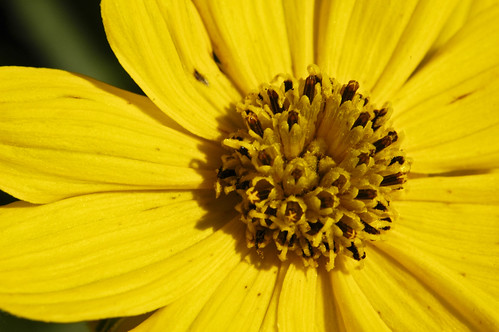prairie coreopsis
(Coreopsis palmata)
Conservation • Description • Habitat • Ecology • Use • Distribution • Taxonomy
Conservation Status |
|
|||||||
| IUCN Red List | not listed |
|||||||
| NatureServe | N5? - Secure SNR - Unranked |
|||||||
| Minnesota | not listed |
|||||||
Description |
||
Prairie coreopsis is a 12″ to 48″ tall, erect, perennial forb that rises on usually one or more stems from a long, creeping rhizome. It sometimes forms dense colonies. The stems are erect, unbranched, and mostly hairless or sparsely hairy at the base of the leaves. They are green with light green vertical stripes. The leaves are opposite, broadly inversely egg-shaped in outline, 1⅛″ to 3⅛″ long, and stalkless or almost stalkless. They are distributed in 6 to 12 pairs along ⅔ or more of the stem. They are usually hairless but sometimes have a few hairs on the margin near the base. The leaf blades are usually divided into 3 lobes well above the base and have the shape of a turkey foot. The lobes are sometimes lobed again, resulting in 3 to 7 (rarely to 9) ultimate lobes. The lobes are narrowly oblong, ⅝″ to 1½″ long, and 1 ⁄16″ to usually ⅛″, sometimes ¼″, wide. Upper leaves are sometimes unlobed. The inflorescence is one to a few flower heads at the end of the stem and from upper leaf axils. The flower heads are 1½″ to 2½″ wide on stalks ⅜″ to 2″ long. The involucre is bell-shaped and is composed of 2 series of bracts, 8 inner bracts and 9 to 12 or more outer bractlets. The inner bracts are yellow-brown, oblong to nearly circular, ¼″ to ⅜″ long, ⅛″ to 3 ⁄16″ wide, and bent backward above the middle. The outer bracts are green, linear, ascending, and about ¼″ long and ⅛″. There are 8 to 10 ray florets and 60 to 80 disk florets. The ray florets are yellow, ⅝″ to 1″ long, and about ⅜″ wide. They are more or less rounded at the tip and may have 2 or 3 (sometimes 4) tiny teeth at the tip. The disk is ⅓″ to ½″ wide. The disk floret is a yellow, 5-lobed corolla tube with a branched style. There is no floral scent. The fruit is a dry seed capsule (achene) that does not have a tuft of hair (pappus) attached. |
||
Height |
||
12″ to 48″ |
||
Flower Color |
||
Yellow |
||
Similar Species |
||
Plains coreopsis (Coreopsis tinctoria var. tinctoria) is much branched above the middle. The leaves are pinnate, bipinnate, or 3 times pinnately compound. The inner bracts on the involucre are reddish. The ray flowers have a red-brown blotch at the center and are divided at the tip into 3 lobes. The disk flowers have a dark tip causing the disk to appear dark. |
||
Habitat |
||
Dry to moderate moisture. Prairies, meadows. Full sun. |
||
Ecology |
||
Flowering |
||
June to August |
||
Pests and Diseases |
||
|
||
Use |
||
|
||
Distribution |
||||
|
Sources |
|||
| 7/15/2022 | ||||
Nativity |
||||
Native |
||||
Occurrence |
||||
Common |
||||
Taxonomy |
|||
| Kingdom | Plantae (Plants) | ||
| Division | Tracheophyta (Vascular Plants) | ||
| Subdivision | Spermatophytina (Seed Plants) | ||
| Class | Magnoliopsida (Dicots) | ||
Order |
Asterales (Sunflowers, Bellflowers, Fanflowers, and Allies) | ||
Family |
Asteraceae (Sunflowers, Daisies, Asters, and Allies) | ||
| Subfamily | Asteroideae | ||
| Supertribe | Helianthodae | ||
| Tribe | Coreopsideae (coreopsis and allies) | ||
| Genus | Coreopsis (tickseed) | ||
| Section | Gyrophyllum | ||
Subordinate Taxa |
|||
|
|||
Synonyms |
|||
|
|||
Common Names |
|||
finger tickseed prairie coreopsis prairie tickseed stiff tickseed wedgeleaf coreopsis |
|||
Glossary
Achene
A dry, one-chambered, single-seeded seed capsule, formed from a single carpel, with the seed attached to the membranous outer layer (wall) only by the seed stalk; the wall, formed entirely from the wall of the superior ovary, does not split open at maturity, but relies on decay or predation to release the contents.
Axil
The upper angle where the leaf stalk meets the stem.
Bract
Modified leaf at the base of a flower stalk, flower cluster, or inflorescence.
Corolla
A collective name for all of the petals of a flower.
Involucre
A whorl of bracts beneath or surrounding a flower, flower head, or flower cluster.
Pappus
The modified calyx composed of awns, scales, bristles, or feather-like hairs in plants of the Aster family such as thistles and dandelions.
Rhizome
A horizontal, usually underground stem. It serves as a reproductive structure, producing roots below and shoots above at the nodes.

Visitor Videos |
|||
Share your video of this plant. |
|||
| This button not working for you? Simply email us at info@MinnesotaSeasons.com. Attach a video, a YouTube link, or a cloud storage link. |
|||
Other Videos |
|||

Visitor Sightings |
|||||
Report a sighting of this plant. |
|||||
| This button not working for you? Simply email us at info@MinnesotaSeasons.com. Be sure to include a location. |
|||||
|
|||||
MinnesotaSeasons.com Sightings |
|||||
Carpenter St. Croix Valley Nature Center Charles A. Lindbergh State Park Kellogg Weaver Dunes SNA, Kellogg Weaver Unit Northern Tallgrass Prairie NWR, Hoffman Unit Northern Tallgrass Prairie NWR, Touch the Sky Prairie Unit Pembina Trail Preserve SNA, Pembina Trail Unit Prairie Creek WMA, Koester Prairie Unit Sand Prairie Wildlife Management and Environmental Education Area Verlyn Marth Memorial Prairie SNA |
|||||

|
Created: Last Updated: © MinnesotaSeasons.com. All rights reserved. |
